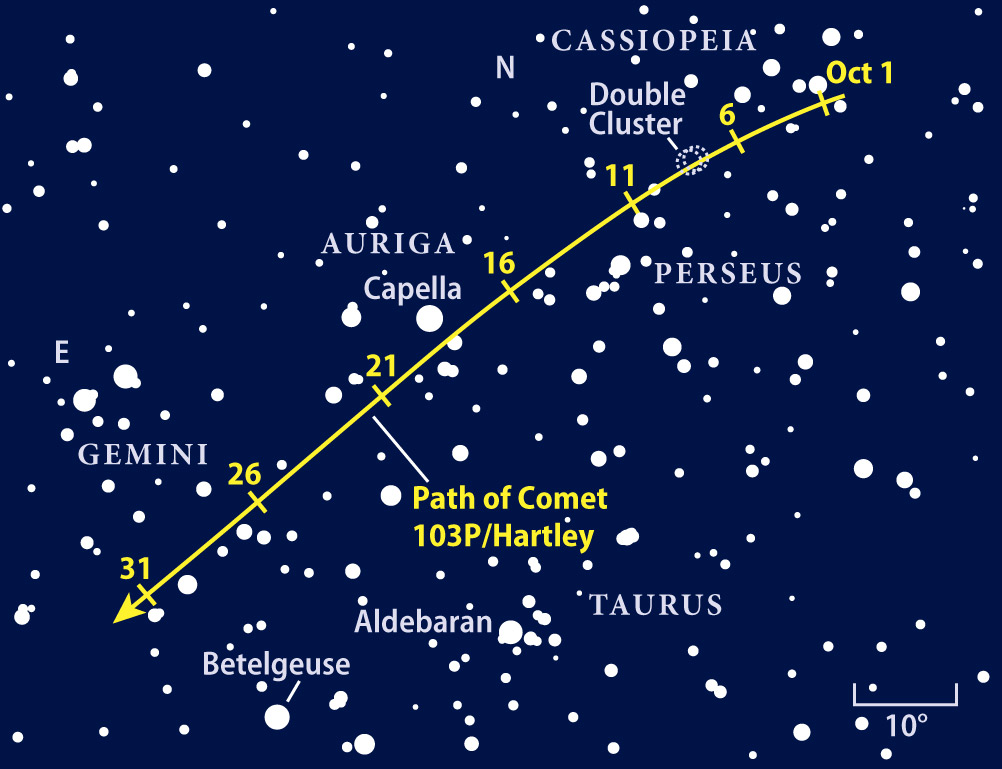Get Ready for a Naked Eye Comet
Source: Astronomy Magazine
I was up early this morning at 2 am Central Time looking at the Comet 103P/Hartley. It was a cool 52 degrees and was perfectly clear with no breeze. I’m near Kansas City, so I needed my binoculars to see the comet.
In fact, if you are near the Missouri-Kansas border, you should try to go to the Powell Observatory in Louisburg, KS on Sat. Oct. 9th. It looks like it’ll be clear. The public program (open to anyone) starts at 7 pm.
Powell Observatory is located about 25 miles south of Kansas City – in Lewis-Young Park, just north of Louisburg Kansas. Click here for more info about Powell Observatory.
I didn’t write what is below. Richard Talcott, senior editor of Astronomy Magazine wrote this.
Comet 103P/Hartley promises to be the brightest comet of 2010, peaking in October
The brightest comet of the year starts to put on a good show in late September before reaching its peak in October. When Comet 103P/Hartley glows at its brightest, it should be visible with naked eyes under a dark sky.

Astronomy: Roen Kelly
Australian astronomer Malcolm Hartley discovered this comet in March 1986. It orbits the Sun once every 6.5 years, traveling from just outside the orbit of Jupiter to nearly Earth’s distance from the Sun. This is the comet’s fourth return to the inner solar system since it was discovered, and its best one yet.
Comet 103P/Hartley should peak at 5th magnitude when it passes closest to Earth in October. A 5th-magnitude star is bright enough to see with naked eyes if you’re out of the city, but a comet’s light spreads out, making it harder to see. Still, you’ll have a good chance to see it without optical aid from a dark-sky site. Binoculars will show the comet nicely, and a telescope will let you see details.
You can start looking for the comet in late September when it lies in the constellation Cassiopeia and remains visible all night. It passes near the star Lambda (?) Cassiopeiae the night of September 29.
Search for Comet 103P/Hartley as it hangs high in the evening sky during October. The brightest comet of 2010 may be visible with naked eyes under a dark sky.
The comet heads to the southeast during October. On the night of October 8/9, it floats next to the famous Double Cluster in Perseus, a pair of adjacent bright star clusters that will form a beautiful backdrop for the comet. It then passes the bright star Capella in Auriga in mid-October. It comes closest to Earth October 20, about the time it will appear brightest in the sky. Unfortunately, a nearly Full Moon then brightens the sky, making the comet less conspicuous.
Comet 103P/Hartley should show two tails emanating from a roughly circular glow, known as the “coma,” which masks the comet’s nucleus. The nucleus is a giant ball of ice and dust that measures about a mile across. As sunlight hits the nucleus, the ice boils off and carries dust with it. This cloud of gas and dust forms the coma.
Sunlight ionizes the ejected gas molecules, causing then to glow with a bluish color. The solar wind carries this ionized gas away from the comet, creating a straight, bluish gas tail. The ejected dust gets pushed away from the Sun more gently, so it forms a curving tail. The dust particles simply reflect sunlight, so the dust tail has a white to pale-yellow color.
Although October marks the peak for Comet 103P/Hartley, the comet will continue to make news in November. NASA’s EPOXI mission will fly past the comet and return stunning images of its nucleus. EPOXI comes closest to the comet November 4, and NASA should release fresh images soon thereafter.
Fast facts about Comet 103P/Hartley
- Australian astronomer Malcolm Hartley discovered this comet in March 1986. When it returned to the inner solar system in September 1991, astronomers firmly established its orbit. Because it was the 103rd periodic comet to be recognized, it received the designation “103P.”
- This comet is the second of three periodic comets Malcolm Hartley has discovered. For this reason, it also goes by the name “Hartley 2.”
- NASA’s EPOXI mission was known as Deep Impact when it flew past Comet 9P/Tempel in 2005. The spacecraft then consisted of two parts: a massive impactor that collided with the comet and a flyby spacecraft that recorded the results. The impact created a bright flash of light as it vaporized a small chunk of the nucleus. The flyby craft lives on as EPOXI.
I hope you get to see Comet 103P/Hartley in the next few weeks.
I hope this makes sense. If you want the right travel insurance advice, call us at 1-888-407-3854 and we'll help you figure it all out.
Now, a word from our sponsor: TripInsuranceStore.com (Travel Forums' Most Recommended Travel Insurance Website)
- Save your time & money with 9 pre-screened companies (you don't need 100+ travel or cruise insurance plans).
- You get personalized service at 1-888-407-3854. Or email us.
- Do you want a relationship with your travel insurance supplier? If so, you'll fit right in. If you'd rather not get to know us, you'll still find everything you need to get the right travel insurance plan.
- Get side-by-side plan & price comparisons
- You get our exclusive Smile of Satisfaction Money Back Guarantee
You must log in to post a comment.